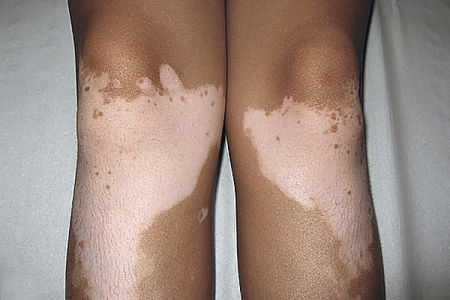Vitiligo: Overview
Vitiligo
What is vitiligo?
Vitiligo is a disease that causes areas of skin to lose color, resulting in spots and patches of lighter skin. Some people develop a few spots. Others have more widespread color loss. Dermatologists offer treatment that may restore lost skin color.
Is vitiligo contagious? No
People of any skin color can develop vitiligo
The contrast between someone’s natural skin color and the lighter patches is greater when the person has a darker skin tone or a tan.

How does vitiligo start?
Vitiligo usually begins with a few small lighter patches that develop on the skin. These patches may stay the same size for years or grow larger. New patches can appear on the skin. The new patches may be close to existing patches or far from them.
If you develop a few spots or patches that appear in one or a few places on your body, dermatologists refer to this as localized vitiligo.
When vitiligo causes scattered patches of color loss on different areas of the body, it’s called generalized vitiligo. While rare, some people lose most of their skin color. This is called universal vitiligo.
There’s no way to predict how much color someone’s skin will lose. There’s also no way to know who will have patches that get larger or where new patches will appear.
What you see when vitiligo begins is also affected by the type of vitiligo you have. The most common type, non-segmental vitiligo, tends to spread slowly with new patches developing off and on throughout a person’s life.
Non-segmental vitiligo
When a person has non-segmental vitiligo, patches tend to appear on both sides of the body like both knees or both hands.

Segmental vitiligo is another type of vitiligo. People who have this type tend to see rapid color loss on one side of the body. After 6 to 12 months, segmental vitiligo tends to stabilize, meaning that the color loss stops. Once it stops, most people with segmental vitiligo don’t develop new patches or spots.
Segmental vitiligo
Also called unilateral vitiligo, this type causes the skin to lose color on one side or part of the body.

Mixed type vitiligo is a rare type of vitiligo. People with this type develop both segmental vitiligo and color loss beyond the area with segmental vitiligo.
Is there a cure for vitiligo?
While vitiligo cannot be cured, treatment may restore lost skin color. Research shows that having an even skin tone can greatly improve both physical and mental well-being.
Can you stop vitiligo from spreading?
Board-certified dermatologists offer treatment that can:
Restore a person’s natural skin tone
Reduce vitiligo from spreading to other areas
No one treatment works for everyone. A dermatologist can tell you what options would likely work best for you.
When it comes to stopping the spread, sun protection is also extremely important. Skin with vitiligo burns easily, as there is no pigment to protect your skin from the sun’s rays. A bad sunburn can worsen vitiligo.
To protect your skin from the sun, dermatologists recommend that you:
Seek shade
Wear sun-protective clothing
Apply sunscreen that offers broad-spectrum protection, water-resistance, and an SPF 30 or higher to all skin not covered by clothing
Avoid tanning
Can you prevent vitiligo?
There is currently no way to prevent vitiligo. If you see light-colored spots or patches on your skin, see a board-certified dermatologist. A dermatologist can tell you whether you have vitiligo or another medical condition. There are many other skin diseases that can cause skin lightening, which can be treated.
If you have vitiligo, the sooner vitiligo treatment starts, the more effective it tends to be. Left untreated for years, vitiligo may be difficult to treat.
To see more pictures that show how vitiligo can appear on the skin, go to Vitiligo: Signs and symptoms.
Related AAD resources
Images
Image 1: Getty Images
Images 2,3: J Am Acad Dermatol 2010;62:945-9.
References
Alikhan A, Felsten LM, et al. “Vitiligo: A comprehensive overview Part I. Introduction, epidemiology, quality of life, diagnosis, differential diagnosis, associations, histopathology, etiology, and work-up.” J Am Acad Dermatol. 2011 Sep;65(3):473-91.
Felsten LM, Alikhan A, et al. “Vitiligo: A comprehensive overview Part II: Treatment options and approach to treatment.” J Am Acad Dermatol. 2011 Sep;65(3):493-514.
Grimes PE. “Vitiligo.” In: Taylor and Kelly’s Dermatology for Skin of Color. (second edition). McGraw Hill, USA, 2016:341-8.
Harris JE. “Translational research in vitiligo: Launching a new era of targeted treatments.” Presented at: American Academy of Dermatology Summer Meeting 2019; July 25-28, New York.
Mazereeuw-Hautier J, Bezio S, et al. “Segmental and nonsegmental childhood vitiligo has distinct clinical characteristics: A prospective observational study.” J Am Acad Dermatol. 2010 Jun;62(6):945-9.
Mu EW, Cohen BE, et al. “Early-onset childhood vitiligo is associated with a more extensive and progressive course.” J Am Acad Dermatol. 2015 Sep;73(3):467-70.
Passeron T, Ortonne JP. “Vitiligo and other disorders of hypopigmentation.” In: Bolognia JL, et al. Dermatology. (fourth edition). Mosby Elsevier, China, 2018: 1087-96.
Rodrigues M, Ezzedine K, et. al. (Vitiligo Working Group). “New discoveries in the pathogenesis and classification of vitiligo.” J Am Acad Dermatol. 2017;77(1):1-13.
Written by:
Paula Ludmann, MS
Reviewed by:
Kesha Buster MD, FAAD
Sandy Marchese Johnson, MD, FAAD
Bassel Hamdy Mahmoud, MD, PhD, FAAD
Last updated: 6/29/22
 Atopic dermatitis: More FDA-approved treatments
Atopic dermatitis: More FDA-approved treatments
 Biosimilars: 14 FAQs
Biosimilars: 14 FAQs
 How to trim your nails
How to trim your nails
 Relieve uncontrollably itchy skin
Relieve uncontrollably itchy skin
 Fade dark spots
Fade dark spots
 Untreatable razor bumps or acne?
Untreatable razor bumps or acne?
 Tattoo removal
Tattoo removal
 Scar treatment
Scar treatment
 Free materials to help raise skin cancer awareness
Free materials to help raise skin cancer awareness
 Dermatologist-approved lesson plans, activities you can use
Dermatologist-approved lesson plans, activities you can use
 Find a Dermatologist
Find a Dermatologist
 What is a dermatologist?
What is a dermatologist?